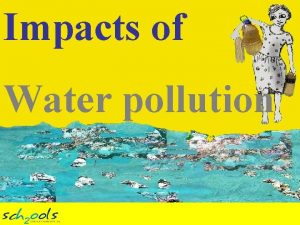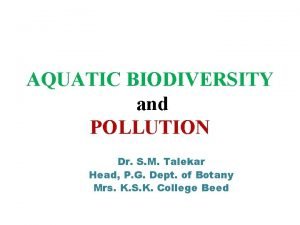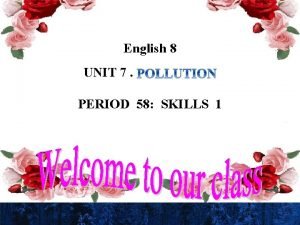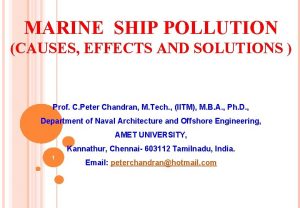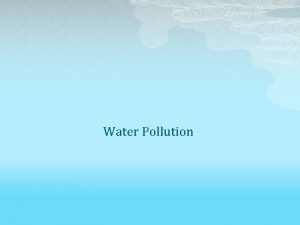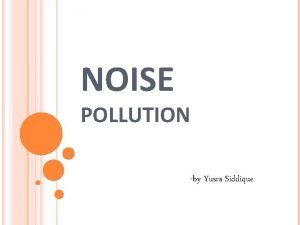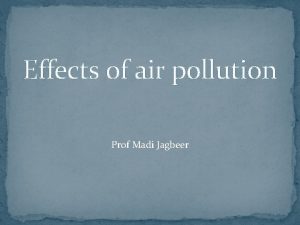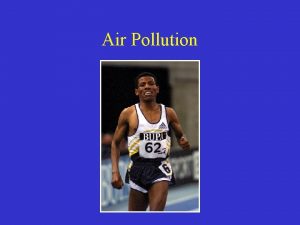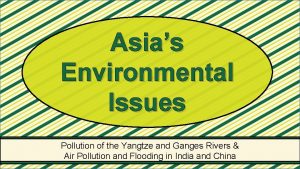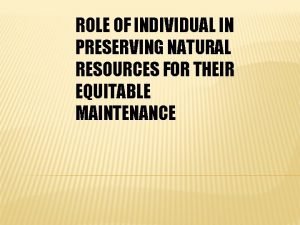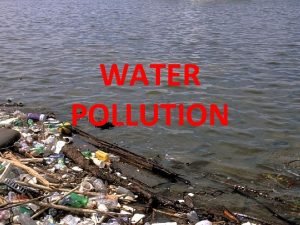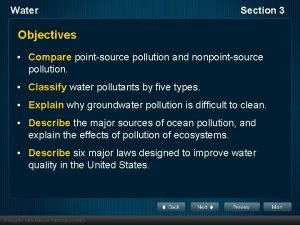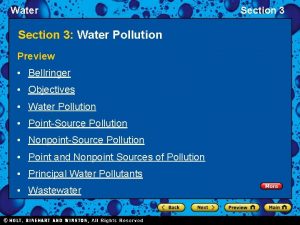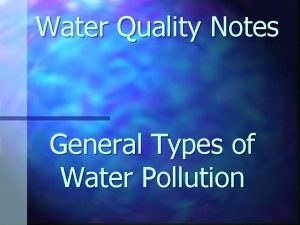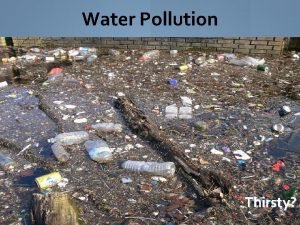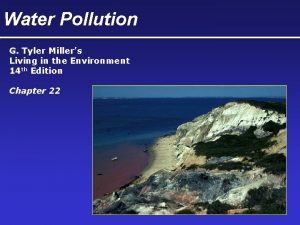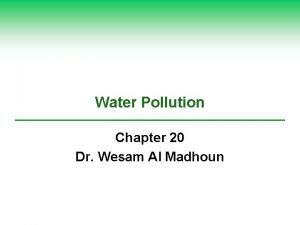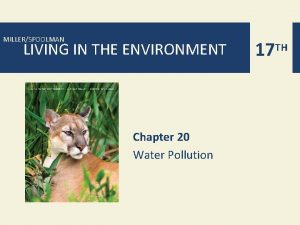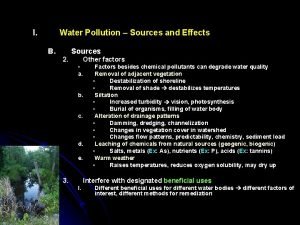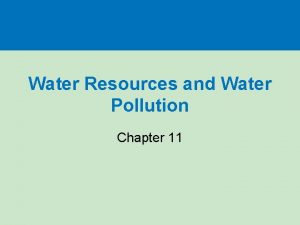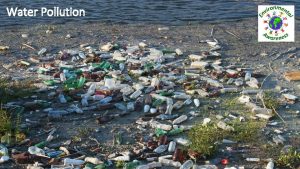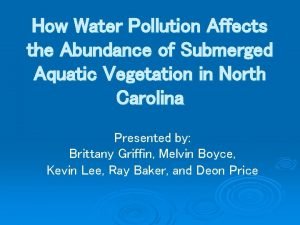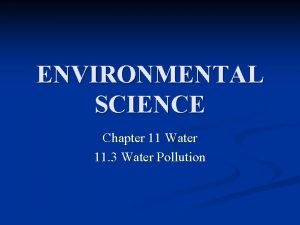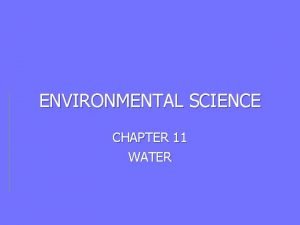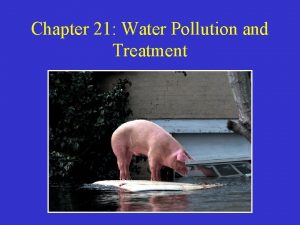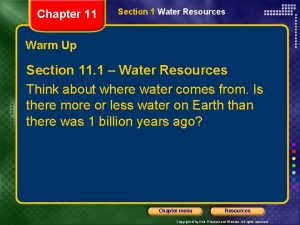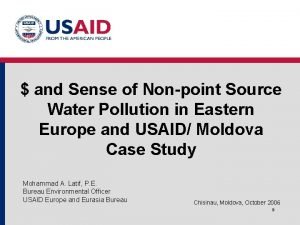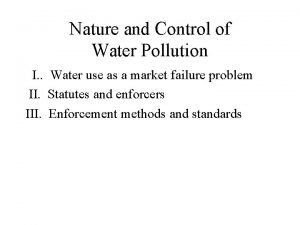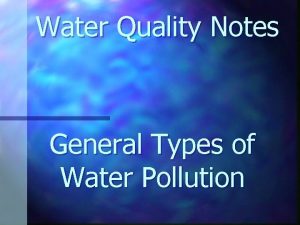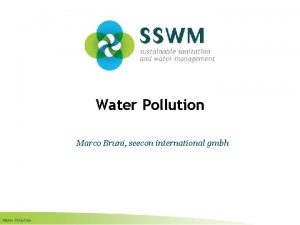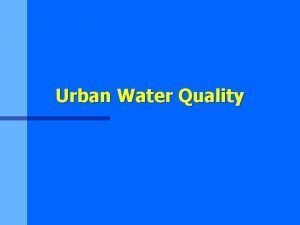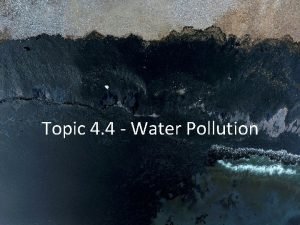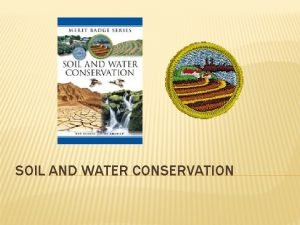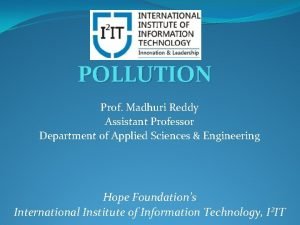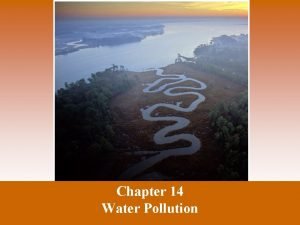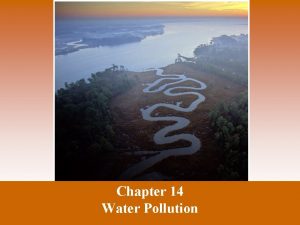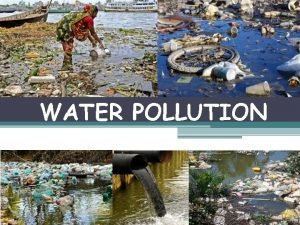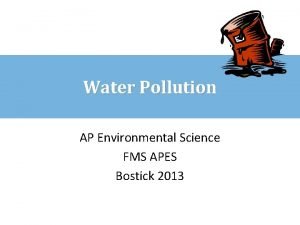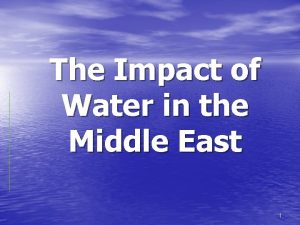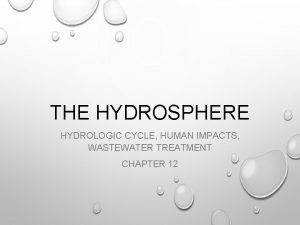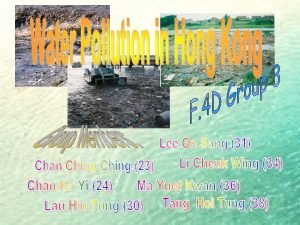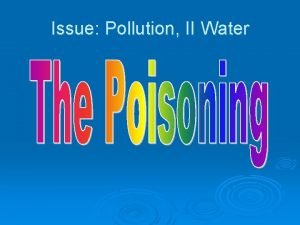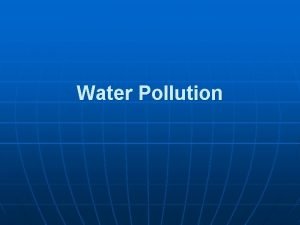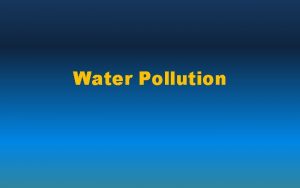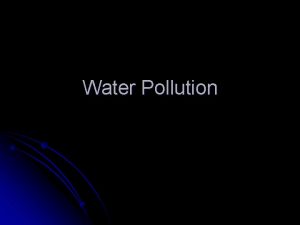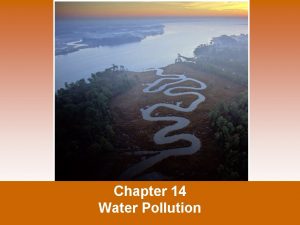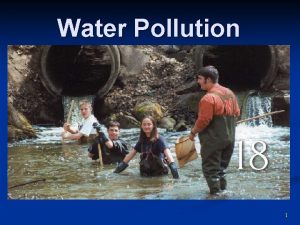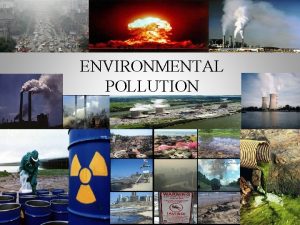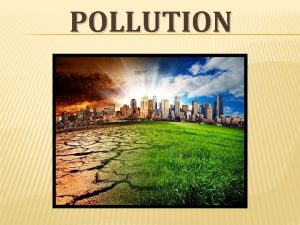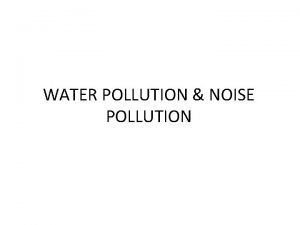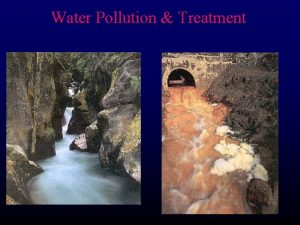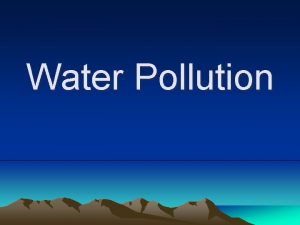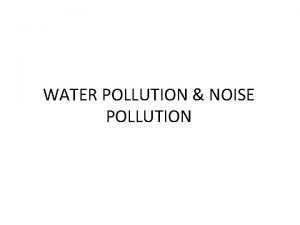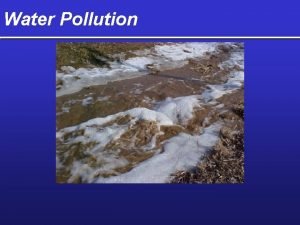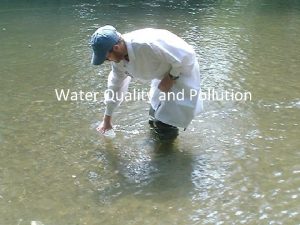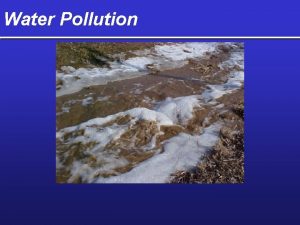Water Pollution Types and Effects of Water Pollution





























































- Slides: 61

Water Pollution Types and Effects of Water Pollution 2009 -10

Infectious Agents n n n Most serious in terms of human health Pathogenic organisms Typhoid, cholera, dysentery, polio, infectious hepatitis, schistosomiasis Insect transmitted-yellow fever and malaria Untreated human waste

Developed vs. Developing Countries n Developed– 90% sewage treatment – 95% clean drinking water n Developing – 2. 5 billion people lack adequate sanitation – 80% of all infectious disease – At least 2 million children die from dysentery

Coliform Tests n n Residents of colon Not pathogenic Detect in water, assume sewage present Figure 20. 4

Oxygen Demanding Waste n n n BOD DO Oxygen Sag Figure 20. 6 “Flowing waters can recover rapidly from degradable, oxygen-demanding wastes and excess heat through a combination of dilution and bacterial decay. ” – BUT……. . cannot recover IF……



Plant Nutrients & Eutrophication n n Oligotrophic -low nutrients and low productivity Eutrophic-rich in organisms and organic material Eutrophication-normal successional process Chesapeake Bay - a story Poisoned Waters - Frontline

Cultural Eutrophication n Increased nutrients-nitrates & phosphates – Fertilizers and detergents – Nitric acid (precipitation_ – Human, animal, and industrial wastes



Process of Eutrophication n Increase of aquatic algae and plants – Algae blooms - primarily summer – Ugly-decrease recreational value n n n Bacterial populations increase Lower of oxygen levels - fish kill Marine-red tides

Pollution of Lakes and Ponds (489)

Toxic Inorganics - Heavy Metals n n n Fatal in as small as parts per million Mercury poison - 1950 s - Minamata, Japan Bioaccumulation -persistent in ecosystems Lead, mercury, cadmium Industrial and leaching from mines

BIOMAGNIFICATION

Toxic Inorganics - Salts n n n Arsenic, chlorides, selenium Road salts Irrigation Mobilization - irrigation and acid precipitation Road salting

Toxic Inorganics - Acids & Bases n n Industries -ammonia, metal plating, petroleum, chemical Home use - dumped into sewers Acid mine drainage-sulfuric “Toxic” precipitation

Great Lakes Region - Water Problems (492)

Organic Chemicals n n n Thousands of synthetic organics Pesticides, plastics, fibers, medicines, gasoline, oil, Many highly toxic Disposal of household and industrial Runoff of pesticides Bioaccumulation and biomagnification

Contaminated Probability 10 to 20 percent Greater than 20 percent Not tested Figure 19 -11 Page 495

Sediments n n n n Largest volume/mass of water pollutants Increased erosion rate - soil loss Fills lakes, obstructs shipping Increased cost for industrial users and water purification plants Block sunlight Smother insects, etc. Carry pesticides, bacteria, fertilizers

Thermal Pollution n Aquatic organisms poorly adapted to changes in temperature Reduce DO Causes – Industrial - especially electrical plants – Loss of riparian buffers – Increased runoff (decreased infiltration)

Water Pollution Control n n n Source Reduction Nonpoint sources and land management Human Waste disposal

Measuring Water Quality n n n Coliform bacteria counts(swimming 200 colonies per 100 ml) DO in water (BOD of waste) Chemical analysis Macroinvertebrate assessment (indicator species) Physical properties: – Temperature – Suspended solids - turbidity

Figure 19 -2 Page 485

Point and Nonpoint n Scattered or Diffuse n May be Episodic n Precipitation acid and toxic rain n Runoff pavement, lawns, farms construction sites Point • Discharge pollution from specific locations – Drain pipes – ditches – Sewer outlets • Discrete and identifiable • Easier to monitor and regulate

Figure 19 -4 Page 486 Ocean Non-point sources NONPOINT SOURCES Rural homes Cropland Urban streets Animal feedlot Suburban development POINT SOURCES Wastewater treatment plant Factory


Coastal Pollution

Cooperstown NEW YORK PENNSYLVANIA ATLANTIC OCEAN Harrisburg NEW JERSEY MARYLAND Baltimore Washington DELAWARE WEST VIRGINIA Richmond VIRGINIA Norfolk Drainage basin Chesapeake Bay No oxygen Figure 19 -14 Low concentrations Page 500 of oxygen

Open Ocean Pollution n Dumping of toxics, human wastes – Common in developing, often shipped from developed!! n n n Radioactive wastes Excessive nutrients Sediments from land – destroying coral reefs

Petroleum – n n Crude and refined – much variation Sources – Accidents (blowouts and tankers – Valedez) Normal operations – 50 -90% - from land sewers!! n n n Effects – many variables Volatile organic hydrocarbons – toxics to many organisms Crude – coats birds and some mammals Coat, smother bottom dwellers Poison bivalves

Toxics in the oceans n n n Metals and slowly degrading chemicals threaten inland coastal waters. Toxic materials settle into sea-floor sediments hazards to benthic organisms that live in and feed on bottom muds. Persistent chemicals may enter the food web and contaminate the fish and shellfish we eat. May bioaccumulate and biomagnify

Debris and trash n Almost 300 miles from the nearest inhabited island over 3000 miles from the nearest continent, Ducie Atoll in the South Pacific is one of the most remote islands

Regulation n n The Law of the Sea limits exploitation The London Convention discourages dumping at sea

Oceans and Nutrient Pollution n n Warning Signs Too many nutrients lead to too little oxygen

Climate Change and the Oceans n n n Oceans are crucial in shaping climate - they store and move heat around the planet – think of ocean currents they're a major source and storehouse for gases (such as carbon dioxide) that affect climate Storms might rage Shores might be submerged § Sea level would rise if the oceans warmed, If polar ice caps melted, sea level would rise further A rise of even a few centimeters would flood lowlying islands and coastal cities. Coral reefs might die back §

Prevention Cleanup Reduce input of toxic pollutants Improve oil-spill cleanup capabilities Separate sewage and storm lines Require at least secondary treatment of coastal sewage or use wetlands, solaraquatic, or other sewage treatment methods Ban ocean dumping of sludge and hazardous dredged material Protect sensitive areas from development, oil drilling, and oil shipping Require improved air pollution cleanup to reduce input from the atmosphere Regulate coastal development Recycle used oil Require double hulls for oil tankers Figure 19 -15 Page 502

Where is Pennsylvania’s Ground Water? Everywhere ! ØBelow Water Table ØFilling pore space ØFilling fractures

5 Years Rechar ge Area A e g r a Rech Discharge Area

Hydrologic Cycle in Pennsylvania

Where is Ground-Water Most Important? >50% Homes >50% GW

Aquifers by Rock Type Sandstone & Shale Carbonate Crystalline Unconsolidated Sand & Gravel

Carbonate Rock Aquifers Sandstone & Shale Carbonate Crystalline Unconsolidated Sand & Gravel

Characteristics of Carbonate Rocks Precipitation ØLarge Openings ØHigh Yields ØVulnerable ØHigh Recharge

Crystalline-Rock Aquifers Sandstone & Shale Carbonate Crystalline Unconsolidated Sand & Gravel

GW Discharge to Streams SHERMAN CREEK STREAMFLOW BASEFLOW 85% Baseflow

Waste Disposal – Septic Systems

Groundwater Pollutants

Wellhead Protection Area contrib Recharge to Supply Well

Factors Related to Bacteria in Well Water • Lack of sanitary seal • Lack of grout

RESOURCE EXTRACTION MINE

Agricultural Sources of Contamination

Sewage Disposal n n n n What goes “down the drain”? What are problems posed by the substances? Natural processes - natures way Outhouses Septic Systems Sewage Treatment Wetlands

Septic tank Nonperforated pipe Manhole (for cleanout) Household wastewater Perforated pipe Distribution box (optional) Drain field Vent pipe Septic System - Name All Parts Gravel or crushed stone

Sewage Treatment

Primary n n Sedimentation Tank Preliminary Metal Grating - large • Undissolved solids settle solids • About 30% efficient Grit Tank

Secondary n n n Biological degradation of dissolved organic matter Trickling Filter or aeration tank Disposal of sludge (anaerobic digestion) 90 -95% efficient Most communities use this

Tertiary Treatment n n n Removes nutrients or other dissolved organic material Expensive Not common

Anaerobic Digestion n n Sludge treatment From where in the sewage treatment process does the sludge come from? Purpose Process End results

Alternatives Wetlands n Natural n Artificial n 20 -30 days Effluent Sewerage • Third World • Hybrid-Septic Tank and central facility from septic tanks
 Water and water and water water
Water and water and water water 8 effects of water pollution
8 effects of water pollution Effects of water pollution
Effects of water pollution What are 5 effects of water pollution?
What are 5 effects of water pollution? Unit 7 english 8
Unit 7 english 8 Pollution causes effects and solutions
Pollution causes effects and solutions Pollution causes effects and solutions
Pollution causes effects and solutions Types of water pollution
Types of water pollution Section 3 water pollution
Section 3 water pollution Land pollution effects on human health
Land pollution effects on human health Sound pollution effects
Sound pollution effects Effect of air pollution in plants
Effect of air pollution in plants General effects of air pollution
General effects of air pollution 5 effects of air pollution
5 effects of air pollution Conclusion of soil pollution
Conclusion of soil pollution Soil pollution images diagram
Soil pollution images diagram Why is water pollution a great concern in southwest asia
Why is water pollution a great concern in southwest asia Domestic pollution
Domestic pollution Aims and objectives of water pollution
Aims and objectives of water pollution Sources of groundwater pollution
Sources of groundwater pollution Explain water pollution
Explain water pollution Water pollution through the years
Water pollution through the years Water pollution solutions
Water pollution solutions What are the terrible twelve water pollution
What are the terrible twelve water pollution Solutions to water pollution
Solutions to water pollution Methods to control water pollution
Methods to control water pollution Ddt water pollution
Ddt water pollution Way to reduce water pollution
Way to reduce water pollution Conclusion of water pollution
Conclusion of water pollution Summary of water pollution
Summary of water pollution Ap environmental science chapter 11
Ap environmental science chapter 11 Objectives of water pollution
Objectives of water pollution Source of thermal pollution
Source of thermal pollution Introduction of water pollution
Introduction of water pollution Chapter 11 section 3 water pollution
Chapter 11 section 3 water pollution Observation for water pollution
Observation for water pollution Control measures of water pollution ppt
Control measures of water pollution ppt High level of pollution
High level of pollution Pollution of water is responsible for
Pollution of water is responsible for Water pollution
Water pollution A variety
A variety Explain water pollution
Explain water pollution Water pollution information
Water pollution information Water pollution
Water pollution Water pollution
Water pollution Chapter 11 section 1: water resources answers
Chapter 11 section 1: water resources answers Water pollution introduction
Water pollution introduction Primary treatment definition apes
Primary treatment definition apes Water pollution in the middle east
Water pollution in the middle east Conclusion of pollution
Conclusion of pollution Water pollution in hong kong
Water pollution in hong kong What is water pollution?
What is water pollution? Water pollution theory
Water pollution theory Conclusion on water pollution
Conclusion on water pollution Water pollution
Water pollution Why is water pollution of great concern in southwest asia
Why is water pollution of great concern in southwest asia Causes and effects of the french and indian war
Causes and effects of the french and indian war What is fresh water allowance
What is fresh water allowance Primary and secondary effects of a tectonic hazard
Primary and secondary effects of a tectonic hazard Pinotubo
Pinotubo Car thrust angle
Car thrust angle Causes and effects of the russian revolution
Causes and effects of the russian revolution


